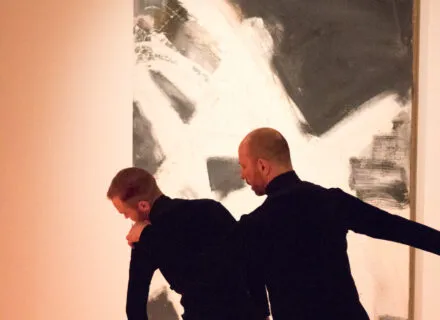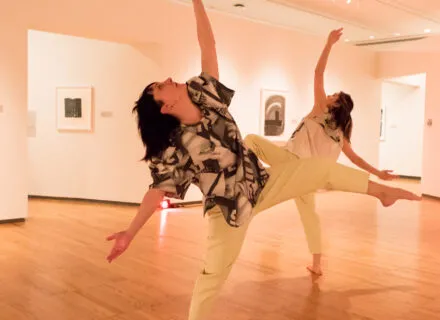
Dance in Museums
By Mariana Seda
As part of their 2022 programming, Krannert Art Museum (KAM) hosted two dance residencies that culminated in immersive live performance experiences. Dance in museums, while not unheard of, introduces visitors to an art form not typically represented in these spaces – a living work made of bodies in motion that cannot be confined to a dated plaque on the wall.
Rebecca Nettl-Fiol, a professor in the Department of Dance, presented Danse Soirée de Bonbons which featured seven dancers performing a series of short works she choreographed over many years. An actor wearing a portable speaker played music, primarily by artist Jacques Brel, and held a sign that read “Follow Moi,” leading the audience through four different galleries as the dances progressed. Nettl-Fiol found that the artworks on display inspired the costumes she ultimately selected for the dancers and even altered the significance of some of the gestures within the pieces. “To have moving art with still art is really special,” said Nettl-Fiol, “one gives meaning to the other, and maybe you see the paintings in a way you wouldn’t see them before.”
As her thesis performance, Kayt MacMaster (MFA ‘22) devised a multimedia immersive dance experience during her one-month residency with KAM. MacMaster’s piece, hog ranch, hogwash, or putting lipstick on a pig, blended elements of scavenger hunts, burlesque historical re-enactments, and museum audio tours to guide the audience through an exploration of women’s lives during the years of American westward expansion. “I was taking a choreographic look at frontierism, specifically women’s roles on the frontier – women who traveled alone and were entrepreneurial,” said MacMaster. As a storyteller, MacMaster was inspired by both historical accounts, and the self-legendizing tales of women from that time. “To a certain extent this is an area of women’s history and representation that is sometimes lost. So, telling these stories, both the truthful and the legendary, is interesting as a feminist act of resistance in reclaiming erasure.” Like in Nettl-Fiol’s piece, MacMaster’s work interacted with both the location and the art works. “My character was invented in that space,” she said, “I was sort of a freakshow – a relic of the frontier. And I performed that piece as if I were an artifact in the museum. I wanted it to be in conversation with this place, this institution, the land, and the museum in general.”


Dance at KAM
Traditionally, dance performance is seen in spaces designated precisely for performance: stages, theaters, large empty rehearsal rooms with wall-length mirrors. Bringing movement into the museum space requires navigating the rules the museum has in place to protect its collection and works of art on display. “The dance programs that took place at KAM this past year were a way to think through, and hopefully expand on, how we view, interact with, and think about visual art and the collection at Krannert Art Museum,” said Liza Sylvestre, curator of academic programs at KAM. “At this moment in time visual art and museums are increasingly responsible for thinking critically about the histories they enforce and carry forward; this includes how accessible they are and who they are accessible to, their relationship to colonization, and their relationship to, and enforcement of, visual dominance.”
For Krannert Art Museum, experimenting with performance art, specifically dance, in their space is not a novel idea. Dating back to 2013, KAM has hosted a variety of dance performance “exhibits” like OPENSTUDIO 2, a collaboration between dance faculty Cynthia Oliver, David Thomson, and Tere O’Connor. “I see enormous potential for the future of performance at the museum,” said Sylvestre. “It presents the opportunity for cross-unit collaborations and, most excitingly, it supports the creation of new ways of making, thinking about, sharing and experiencing art.”
